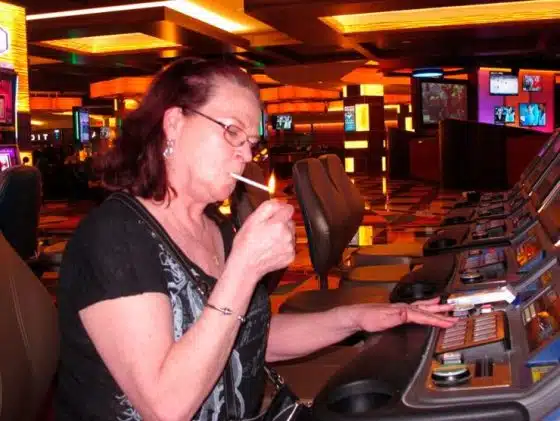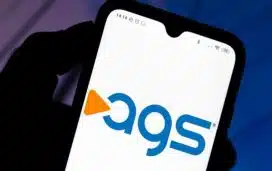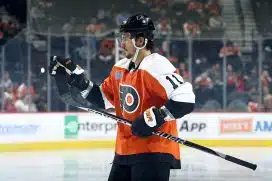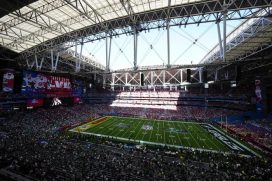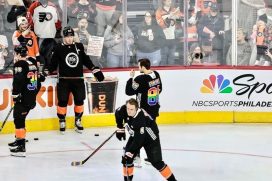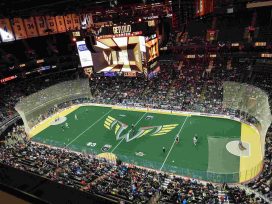Patrick Causey, on Twitter @PatrickCausey
Saturday night, at 9:43 pm, Adrian Wojnarowski dropped one of his vintage Woj bomb's on the NBA that was about as expected as the ending to season five of Game of Thrones:
Yahoo Sources: Philadelphia's Joel Embiid suffers setback in healing process, must sit-out thru further evaluation. http://t.co/yLHyP8xEvT
— Adrian Wojnarowski (@WojYahooNBA) June 14, 2015
The news spread like a wildfire among NBA ranks, and particularly, in Philadelphia, where it just reaffirmed the collective paranoia of a fan base that has come to expect the worst after decades of disappointment.
Scratch just beneath the surface of this team's history and you begin to understand why many are convinced the Sixers (and all Philadelphia sports teams, for that matter) is governed by Murphy's law.
This is the same franchise, after all, that ends up with the number two pick when Evan Turner is available instead of Kevin Durant. The same franchise that traded a fortune for Andrew Bynum only to see him play as many minutes for the team as my 95-year old grandmother. And it is the same franchise that traded Moses Malone and Brad Daugherty for Roy Hinson and Jeff Ruland (if you just said "who" after reading the latter two names, you've proven my point).
So of course the Sixers would leave one of the deepest drafts in recent memory with a superstar talent that can't take flight because of a broken wing. Had lady luck smiled on this fan base, this city, this team, perhaps we would have ended up with the number one pick Andrew Wiggins and look on with a faint sense of sympathy to whatever fan base ended up with Embiid and his broken foot (and back).
But that just wasn't in the cards. Embiid is ours, for better or worse. Now comes the hard part: regrouping, and sorting through the rumors and speculation to figure out what this "setback" means for the Sixers moving forward. Here are five points that emerge from the wake of this news.
1. The timing of the Sixers press release gives reason for concern
As other reporters have written, the timing of the Sixers' carefully orchestrated press release should give you pause for concern. There is an old adage in the news industry that you can bury a story by releasing it on a Friday afternoon. The story, in theory, should be drowned out by the distractions provided by the weekend, and will become forgotten once the news cycles on to the next breaking story.
Pushing that press release to Saturday night — and make no mistake, the Sixers knew well before then — was not by accident. The Sixers carefully timed this release to minimize the blow back the organization felt. Of course, thanks to social media and the passion with which Philadelphia fans follow their teams, the Sixers' efforts to bury the story were nothing short of an abject failure. But it gives insight into the team's thinking, and suggests that the long term prognosis of Embiid's health was anything but good.
It is equally troubling that the Sixers said anything at all. This is Sam Hinkie we are talking about. The same executive who treats his draft plans like matters of national security. Last season, he did not say a word to the press from the draft lottery in May until the draft at the end of June. The team refused to release names of players that it worked out, kicked media out of the facility for trying to interview Andrew Wiggins during a secret workout, and locked out the media from the team's facility during the NBA draft.
The fact that Hinkie and company broke protocol is more telling than the actual statement the team released.
2. Embiid's "setback" is Exhibit A for why you draft BPA
The Sixers, in theory, were loaded on the front line with Embiid, Nerlens Noel and Dario Saric, who may or may not be joining the team next year. Meanwhile, the Sixers have gaping holes every where else, but especially at the point and the wing. The popular narrative therefore became that the Sixers should take D'Angelo Russell over, say, Jahlil Okafor, regardless of whether Russell was the better prospect.
This "setback" is a sobering reminder that there are no guarantees with NBA draft prospects. Even those that seem destined for stardom can come crashing back down to Earth. It's why you always draft the best player available, regardless of positional need.
The most famous example, of course, was the Portland Trail Blazers decision to draft Sam Bowie over Michael Jordan because they had Clyde Drexler in the mix. I wrote about this leading up to the draft lottery:
"Everyone knew that Jordan was a sure thing. The Portland Trail Blazers knew it. But they had Clyde Drexler at shooting guard.
Bobby Knight had just finished coaching Jordan during the USA's gold medal run in the 1984 Olympics. He saw first hand how special Jordan was, and implored his close friend Stu Inman, who was Portland Trail Blazers General Manager, to draft Jordan.
"But we need a center," Inman said.
"So play him at center!" Knight yelled back.
Inman never listened. The Blazers drafted Bowie, whose career was cut short by debilitating injuries. While Jordan was…. well… you know already. And the rest, as they say, was history."
There are no guarantees in life but death and taxes. When faced with the chance to get a top flight player, a team in the Sixers' position needs to grab that chance and deal with the resulting fallout later.
I think the Sixers would have stuck to this best player available approach, regardless of the reaction from the fans and media alike. It was the fans that wanted to win rightnow that I was worried about. Perhaps this latest injury scare will soften the blow for some if the Sixers end up with Okafor (assuming, of course, they think Okafor is the higher rated prospect).
3. The Sixers took an unnecessary risk drafting Embiid
There has been a lot of criticism levied at the Sixers since the news of the Embiid setback broke, some of it fair, some of it not.
I think it is entirely fair to criticize the selection of a 19-year old center that had a fractured back and a fractured navicular bone in his left foot. Those types of injuries are problematic for any professional athlete, but especially men as large as Embiid, because they are made worse by excessive weight bearing activities:
"A stress fracture of the navicular typically occurs over time with excessive weight bearing activity such as running, sprinting, jumping or dancing. They often occur following a recent increase in activity or change in training conditions (such as surface, footwear or technique changes etc)."
By their nature, large men such as Embiid place more pressure and weight on their navicular bone, making it harder to allow the bone to fully heal.
ESPN.com's Kevin Pelton did a study on the history of NBA players recovering from the navicular injury, and it revealed a wide-range of possible outcomes for Embiid.
On the positive side, Michael Jordan missed his second season with the injury, and went on to become the best player in league history. Zydrunas Ilgauskas played 756 of a possible 902 games since he suffered that injury in his rookie season. Kevin McHale had similar success, playing 419 of a possible 492 games. Those represent the best case scenarios for Embiid.
On the flip side, Philadelphia's own Andrew Toney missed the entire 1985-86 season after suffering the same injury and was never the same again. Bill Walton played only 259 of a possible 738 games and Yao Ming played 82 of a possible 246 games. The latter two examples are the worst case scenario for Embiid; a harrowing reminder of just how fickle the navicular bone can be for a 7'0 big man putting enormous stress on his foot.
Sam Hinkie was front and center for the Ming injury, working in the front office of the Rockets during this time. So he saw how quickly the injury could end an otherwise promising career.
One might look at those odds of a big man recovering from that injury– which seem to be 50/50 — and assume that Embiid was worth the risk. He was considered one of the best prospects to come out in the last decade plus. Certainly you can take those odds in order to acquire a potential franchise caliber building block.
If it was just the foot injury, I would agree with you. However, Embiid also had a stress fracture in his back, which he suffered after playing just 28 games of college basketball. If Embiid came away with two significant injuries after just 28 games of college basketball, how reasonable was it to expect him to survive an 82 game season in a much more physical league?
While there was a chance Embiid could fully recover and go on to reach his considerable talents, there was an equal, if not greater chance that Embiid would never be able to stay healthy.
I would have much preferred the Sixers give up their 3rd and 10th pick to the Cavs in exchange for the chance to draft Andrew Wiggins. If the Cavs wouldn't bite, I would have erred on the side of caution and drafted Dante Exum, a player that has considerable upside in his own right. Perhaps his ceiling was lower than Embiid's, but that assumes Embiid would actually be healthy. And given Embiid's injury history, upside doesn't matter much if you're never on the court.
4. But Embiid's "setback" does not de-legitimize the Sixers' plan
This is where I think it will become very hard for Sixers fans to compartmentalize the Embiid injury. Because while it is fair to criticize the Sixers decision to draft Embiid, his injury should not be used as a reason for dismissing the Sixers plan for rebuilding this team.
As I've laid out in prior posts, when Sam Hinkie took over the Sixers after the 2012 season, they were in the proverbial "no man's land" of the NBA: too good to get a high draft pick and land a franchise caliber player, but too mediocre to compete for an NBA title as constructed or entice other NBA superstars to join their cause. LeBron James or Kevin Durant weren't getting excited about signing up with Jrue Holiday, Evan Turner and Thaddeus Young.
So I can't fault the Sixers for taking drastic measures. Yes, it meant tanking for two seasons. And yes, the Embiid injury could set that timeline back even further. But they had already wasted approximately eight plus years living the basketball equivalent of Ground Hog's Day: get the eight seed, lose in the first round, overspend on mid-level free agents, rinse and repeat.
What was another few years if it meant something much greater?
Consider this: would you rather be where they are now — with Noel, the #3 pick, Saric, four first rounders in 2016, the most cap space in the league and whatever Embiid can provide us — or the 2012 roster that included Bynum, Holiday, Turner, Richardson, Hawes and Young, and almost no cap space to add free agents?'
Is that even really a question?
5. Hinkie deserves credit for safeguarding against this from happening
This is where I try to cheer you up. Because while the Embiid news is a devastating blow to the Sixers, it is not the death knell of their franchise by any stretch of the imagination.
Hinkie deserves credit for safeguarding against the potential reality where Embiid does not move the needle forward on the Sixers quest to win an NBA championship. As you can imagine, Hinkie is no dummy. He knew about and fully analyzed this potential outcome, and made moves with an eye looking towards the future as a result.
Consider the following quote from Hinkie: "I believe a lot in optionality—a lot," Hinkie said after last February's trade deadline, according to the Philadelphia Inquirer's Keith Pompey. "I believe a lot in [being] flexible. I believe a lot in making a decision as late as you possibly can to gain as much information as you can."
And this: "We will not bat 1.000 on every single draft pick," Hinkie said, per CSNPhilly.com's John Gonzalez. "We have them by the bushelful, in part, because of that. Because we don't have any hubris that we will get them all right."
The Sixers still have the #3 overall pick in this draft. They still have Dario Saric, who has been absolutely dynamic in Europe, waiting in the wings. They still own the Lakers top 3 protected first round pick, a pick which should yield a significant return unless the Lakers are able to pull a rabbit (or 3) out of a hat this offseason and vastly improve their team. And they still own two other first round picks next year, plus their own lottery selection. If Embiid is about to have another surgery, it is safe to say that the Sixers pick will have a good chance of being in the top 5 again.
In other words, the Sixers are still positioned to add potential franchise caliber players this season and next. So while there is one big reason to be down on the Sixers future right now, there are about six or seven reasons to remain optimistic. And that's all we can ask for at this point. Is there really a better alternative?

